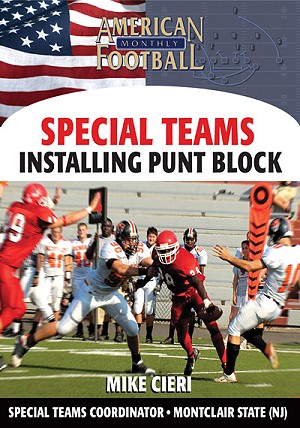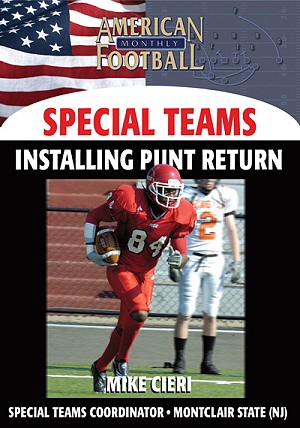By Mike Cieri, DL and Special Teams Coach
Montclair State University
The Montclair State University Red Hawks Football program considers Special Teams to be the “Heart and Soul” of the football operations. The Red Hawks’ approach to Special Teams enables the coaching staff to identify skill players such as swatters, punt blockers, scoop and scorers, punt returners, and the trail and fit personnel needed for a sound and effective punt pressure unit. Once the players are identified through thorough circuit drills and a thorough specialist period, schemes are developed to combat various punt alignments and blocking / coverage used.
This article is two-fold. First it will deal with our selection process, the development and reinforcement of individual player skills and secondly, show how a basic scheme is developed to meet an array of protections & coverage that could be seen in a game.
Working a batter of progression drills in the spring, preseason and during season, not only helps the coaching staff select the players best suited to the job descriptions but gives us an opportunity to hone the skill level of players with an on-going process. By utilizing a man scheme philosophy, special teams’ players learn the techniques; maximize their efficiency while developing a pool of players who can be counted on without losing the special team effectiveness. This concept is true for all our special teams and not just punt pressure unit.
The punt return and block core principles (Shock: block & hold up / Mirror: downfield fit and block) are introduced and drilled to players in a series of station circuit drills. The specialist we are developing with these drills would be the block specialists and trail & fit (basic techniques for the swatters) personnel. Returners along with swatters/stingers are further developed during the specialty periods and specific individual drills.
The following punt pressure drills are taught in meetings prior to that practice emphasizing the skills needed to be developed (part method) and how that technique fits into the scheme (whole method). Each of the drills are performed for 5 minutes on designated days. Players are divided based on previous knowledge of skill type but all players rotate those of the development.

The center snaps the ball and a rusher explodes off the line of scrimmage from a modified sprinter stance. Having great get-off is one of the key attributes to be block specialist. Another player stands two and half yards off the ball inside a standard hula hoop holding a hand shield while on the outside of the hoop 1 yard away in a foam roller creating a track for the rusher. As the rusher approaches, the shield-holder lightly pushes the shield down on the rushers shoulder and back. The rusher must keep his shoulder pads under the shield, plant his outside foot straight up-field, dip and rip, stay bent, point inside and explode to the punter. The hula hoop and foam roller helps keep the footwork tight to the body. Another method is using an open linemen’s chute to keep the rusher low. The punter will hold the ball out at the block point for the rusher.
The rusher will accelerate to the ball using proper hand placement when they get to the ball. At the ball the hands will be crossed over and will push the ball down. Two rushers from each side do the drill simultaneously with the non-designated rusher as the scoop and score. After the ball is batted down, the scoop & score player recovers the ball and sprints up-field.

Another advanced drill to teach punt pressure players the proper approach to block a kick based on the punter’s foot and block point from various get – off positions is ‘Run the Hoop’. Place 4 hula hoops as shown in the diagram and space them out according to the alignment of the punt unit. On the snap of the ball, one rusher takes-off towards the punter using the proper rush techniques as described in ‘low pad level’ drill. This drill is rapid fire moving down the line. If the punter is right –footed, the outside rushers on both sides and the inside rusher away from the punter’s kicking leg cross over the punter’s leg to block the kick. However, the inside rusher to the kicker’s foot side must get to the block point sideways (i.e. turning parallel to the kicker’s leg) sliding past the kicker to avoid his leg. This drill will teach proper block technique and develop the body balance and hand coordination to prevent any penalties. If it is a left-footed kicker, all components of the drill are opposite.


The Shock Hold –up drill is based on the type of blocking we will be seeing and technique we will use to delay the coverage downfield. The blocks we encounter during the season are kick – slide (Pro Punt Protection) and Hit & Run (Shield Punt Protection). For kick slide we will be in a modified sprinter stance (3 pt) and for the other two we will be in a 2 pt. athletic stance. Drive and come to balance for the kick slide begins with the blocker pass setting off the LOS as quickly as possible. A center snaps the ball and a rusher explodes off the line of scrimmage from a modified sprinter stance. The rusher must make up ground, get to the blocker quickly and use his hands with a shock & lock technique (similar to a defensive linemen’s jam). The rusher continues to run his feet driving the blocker back. At no time during the push back should the rusher drop his hands. By scheme, the rusher will know what shoulder to attack (force) staying square on 65% of the blocker’s body. When the blocker’s first attempt to escape happens, the defender drops his hands, gets his feet underneath him (comes to balance), turns and looks for the returners / ball position. The rusher now becomes a trail and fit player. The trail and fit player once the returner/ball position is located, immediately sprints on an angle towards the returner. This is a different technique than the traditional trail and fit like a defensive back in-phase with a receiver. We will have 4 players going at one time (two on each side of the center about 5 to 7 yards apart). A punter/coach will punt/throw the ball to a returner to the right, middle and left so that the trail and fit player can locate the ball and sprint on the proper angle

If we encounter a team that uses Hit & Run (Shield Punt Protection) we use a mirror technique as an offensive lineman would use on pass protection. Once again the set – up for this drill will be the same as the kick – slide as describe above (two blockers on each side of the center). The rushers would like up in a two-point stance across from the blockers. On the snap, the blocker moves and the rusher mirrors staying in front of him. The blocker can shuffle, juke, spin or bull rush to get off of the rusher and get to coverage. There are three main coaching points. First, the rushers must maintain the proper pass protection posture (hands up, elbows tight, hands at the chest, chest proud, wide base, bend in the knees). Secondly, keep eyes on the blocker, move feet according while keeping a strong wide base, never crossing over the feet, never lunging forward, keeping hands up. Lastly, read the release & engage the blocker with your hands, lock out the hands and arms and jumping the feet back to maintain leverage. When the blocker’s first attempt to escape happens, the defender drops his hands, gets his feet underneath him (comes to balance), turns and looks for the returners / ball position. The rusher now becomes a trail and fit player. The trail and fit player once the returner/ball position is located, immediately sprints on an angle towards the returner. This phase is identical if the punt team employed the kick-slide protection.

To be continued, Part II will be posted tomorrow
Videos by Coach Cieri:

